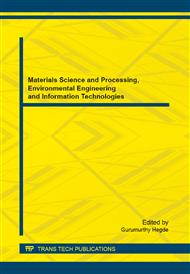[1]
H.G. Qin, W.L. Sun, G. Li, et al. Preparation and Properties of Foam Concrete with Inorganic Lightweight Tailings, J. Scientific Journal of Materials Science. 3(2013)103-107.
Google Scholar
[2]
E.K. K Nambiar, K. Ramamurthy. Models relating mixture composition to the density and strength of foam concrete using response surface methodology, J. Cement & Concrete Composites. 28 (2006) 752–760.
DOI: 10.1016/j.cemconcomp.2006.06.001
Google Scholar
[3]
Technical specification for application of lightweight foam concrete. GTJ32/TJ 104-2010, Nanjing; (2010).
Google Scholar
[4]
W.X. Wang. Study on the correlation of the oven-dry density and compressive strength of foam concrete, J. China Concrete. 6 (2010)50-53.
Google Scholar
[5]
Y.Q. Li, L.D. Zhu, J.L. Li, et al. Study on mix ratio design of foamed concrete, J. Journal of Xuzhou Institute of Technology(Natural Sciences Edition). 26(2011)1-5.
Google Scholar
[6]
P.E. Regan, A.R. Arasteh. Lightweight aggregate foamed concrete, J. Struct Eng. 68(1990)167–173.
Google Scholar
[7]
Foamed concrete block. JC/T 1062-2007, Beijing; (2008).
Google Scholar
[8]
R.C. Valore. Cellular concrete part 2 physical properties. ACI J 1954, 50: 817–836.
Google Scholar
[9]
M. Visagie, E.P. Kearsely. Properties of foamed concrete as influenced by air-void parameters, J. Concrete/Beton. 2002(101): 8–14.
Google Scholar
[10]
D. Aldridge, T. Ansell. Foamed concrete: production and equipment design, properties, applications and potential. In: Proceedings of one day seminar on foamed concrete: properties, applications and latest technological developments. Loughborough University; (2001).
Google Scholar
[11]
H. Weigler, S. Karl. Structural lightweight aggregate concrete with reduced density – lightweight aggregate foamed concrete, J. Lightweight Concr. 2 (1980)101–104.
DOI: 10.1016/0262-5075(80)90029-9
Google Scholar
[12]
Z.H. Pan, L. Cheng, D.X. Li, et al. Research on the preparation technology of new high performance foam concrete, J. New Building Materials. 5 (2002)1-5.
Google Scholar
[13]
S. Karl, J.D. Worner. Foamed concrete-mixing and workability. In: Bartos PJM, editor. Special concrete-workability and mixing. London: E&FN Spon; 1993, p.217–224.
DOI: 10.1201/9781482271379-36
Google Scholar
[14]
E.K.K. Nambiar, K. Ramamurthy. Influence of filler type on the properties of foam concrete, J. Cement & Concrete Composites. 28 (2006)475–480.
DOI: 10.1016/j.cemconcomp.2005.12.001
Google Scholar


